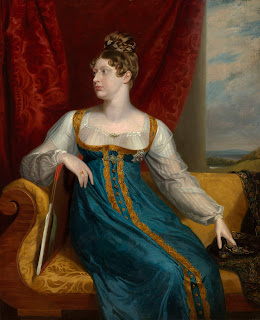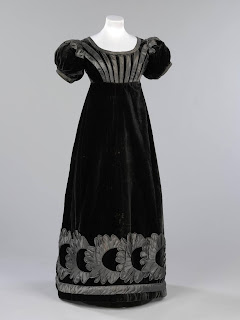My big initial questions
Day vs Evening dresses. Walking dresses. Practicalities based on Promenade dress vs dancing dress.
So, continuing on from my general musing on what "I" would have been most likely to wear, I also started to consider practicalities. These practicalities are twofold:
- Where will I be, what will I be doing, and what time of year?
- What is my realistic budget (financial & chronological)?
The answers to this are:
Question 1:
- Bath, so England, and more to the point, outside in the Promenade
- Walking and "showing off"
- Late summer into Autumn
Question 2:
- Financially
- If I spread financial costs, then I can afford a nice-but-not-elite dress. So good quality fabric, but probably not 100% natural fibres unless there's a nice sale on with what I need.
- I might be able to make a cheap polycotton test run dress, but otherwise I will only be able to afford the fabric for the main dress. Fabric, followed by notions, will probably take the largest portion of my budget.
- New era: Also, this is one event, so it's not reasonable to invest that much into a new era which I may not regularly return to.
- Chronologically
- I am a slow sewer, and as I currently do not own a sewing machine - the one I use is locked down at the opposite end of the country from me right now - I will be hand-sewing everything to begin with, so I feel that it would be more realistic to make one versatile dress, rather than separate day, walking or evening dresses.
- I will need to make/obtain a shift, stays, and a petticoat (or two) at a minimum, and will have to make the appropriate financial or chronological adjustments to own them. This affects the dress in that time spent on those layers takes away from time available to make another dress.
- Time also means that a very decorated or fancy dress would be less practical. One with clean lines, and relatively simple decoration will be easier to complete well within the time constraints.
Decision:
A walking dress would be ideal, but a day dress would be more versatile and could even potentially be an evening dress with appropriate accessories.
Inspiration
These two dresses are the two I feel completely in love with. Initially the colour caught my attention, but each has elements which I really like, and which also fit with the "me" I want to portray.
The dress on the left is listed in the 2016 Cora Ginsburg catalogue (PDF). It is described as being from the USA and of "Clarence-blue silk twill" or of "levantine", and is dated to c1818. The deep blue shawl Kashmiri shawl isn't original to the outfit, but would be appropriate to the period. I adore the details at the cuffs, the shoulders, and across the chest, but I suspect that my skills aren't quite there yet.
The second dress is in the DAR Museum, and is dated to c1818-1820. This dress is also described as being in "Clarence-blue" silk, and I freely admit to having fallen in love with the colour of both these dresses. The dress does not appear to be made of a "shiny" silk, but rather a crepe.
The decoration on this dress is in the form of bands of shiny bias-cut satin silk that has been sewn on around the shoulder caps, on the cuffs, and at the hem; three bands in each location. There is also another band of the same contrasting fabric around the high waist. The triple bands sewn at the edges of the shoulder caps and those at the cuffs are all of narrow equal widths; probably a few cms at most. In contrast the bands at the hem are graduated in width towards the hem, and are significantly wider.
The sleeves appear to have an extra frill at the edges of what looks like lace. The neckline is simple and the Museum has chosen to fill it in with a file almost transparent ruffed chemisette, and it is not clear whether this is also at the cuffs, or if that is a separate piece of decoration.
It is interesting that both these dresses are believed to have been made and worn in the USA, but are in a colour that because famous and fashionable specifically due to Princess Adelaide, who married the British Duke of Clarence in 1818 (hence the name). It is believed to have been her favourite colour.
Unfortunately I've not been able to find any fabrics being sold specifically as "Clarence blue", but I have found some modern shades which seem to approach this blue-with-a-greenish-hint. More on that in a later practicalities post.
Other dresses I liked
...but ultimately haven't gone with (this time?)
1. Princess Charlotte's Russian Dress
(That's it's actual name!)
I saw this one in an exhibition at the Queen's Gallery a little while back, and I still love it. It's definitely on my list of dresses I'd like to recreate one day.
2. Tat'yana Borisovna Potemkina, by Vigée-Lebrun, 1820
I love the colour and the cross-over style front. The long sleeves with the lace are also quietly beautiful.
3. Jane Johnstone's Mourning Dress
This dress in the V&A is marginally later than I was originally looking at, but I love the simplicity and shape of the bodice decoration. I'm also a big fan of both black and of velvet, although I've not sewed it in decades. My other half likes the decoration on the bottom, as well, so we both like different elements of it. I think this one is on one side for if I ever need a regency or even early Victorian evening/ball dress.
© Victoria and Albert Museum, London
Formal mourning dress of black velvet and grey silk satin decorated with satin piping and appliqué. The dress is full length and has a wide, shallow neckline outlined with grey satin piping. It is lined with cream silk in the bodice and black silk grosgrain in the skirt. The short puff sleeves are decorated with an appliquéd satin motif stemming from the shoulder seams and are finished with the same satin piping. The waist is high but falls a good 5-10cm under the bust. Decorative lines of satin appliqué stem from the waistline to the neck and shoulder seams on the front of the dress and two lines of piping form a V shape from the waist to the shoulder seams on the back of the dress. The dress fastens at the back from the waist to the neck with seven hooks and eyes and a drawstring at the neck. The skirt is gored with a circumference of 220cm around the hem and is gathered slightly at the waist. The hem of the skirt is appliquéd with a wide band of an overlapping, simplified floral motif in grey silk satin, underlined with a band of satin piping.











No comments:
Post a Comment